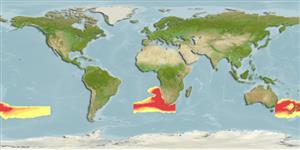Issue
Family placement uncertain (Ref. 1830).
Environment: milieu / climate zone / depth range / distribution range
Ecologie
marien bathypelagisch; diepte 26 - 950 m (Ref. 2710). Temperate
South Atlantic, central South Pacific, and off S and SE Australia.
Grootte / Gewicht / Leeftijd
Maturity: Lm ? range ? - ? cm
Max length : 8.0 cm TL mannelijk / geslacht onbekend; (Ref. 2710)
Korte beschrijving
Determinatiesleutels | Morfologie | Morfometrie
Dorsale stekels (totaal) : 9; Dorsale zachte stralen (totaal) : 9 - 10; Anale stekels: 3; Anale zachte stralen: 7 - 8. Dark brown with silvery reflections (Ref. 2710).
Feed on pelagic crustaceans (Ref. 58748).
Levenscyclus en paargedrag
Maturiteit | Voortplanting | Paaien | Eieren | Fecunditeit | Larven
Heemstra, P.C., 1986. Acropomatidae. p. 561-563. In M.M. Smith and P.C. Heemstra (eds.) Smiths' sea fishes. Springer-Verlag, Berlin. (Ref. 2710)
Status op de Rode Lijst van het IUCN (Ref. 130435: Version 2024-2)
Gevaar voor de mens
Harmless
Gebruik door de mens
Visserij: van geen belang
Tools
Speciale rapporten
Download XML
Internetbronnen
Estimates based on models
Preferred temperature (Ref.
123201): 8 - 15.2, mean 11.7 °C (based on 80 cells).
Fylogenetische diversiteitsindex (Ref.
82804): PD
50 = 0.5176 [Uniqueness, from 0.5 = low to 2.0 = high].
Bayesian length-weight: a=0.01122 (0.00514 - 0.02450), b=3.04 (2.87 - 3.21), in cm total length, based on all LWR estimates for this body shape (Ref.
93245).
Trofisch niveau (Ref.
69278): 3.1 ±0.30 se; based on food items.
Weerstandsvermogen (Ref.
120179): Hoog, minimale populatieverdubbelingstijd minder dan 15 maanden (Preliminary K or Fecundity.).
Fishing Vulnerability (Ref.
59153): Low vulnerability (10 of 100).
Nutrients (Ref.
124155): Calcium = 58.5 [17.8, 306.2] mg/100g; Iron = 0.556 [0.154, 2.128] mg/100g; Protein = 3.49 [0.00, 7.44] %; Omega3 = 0.54 [0.17, 1.92] g/100g; Selenium = 9.03 [1.47, 43.33] μg/100g; VitaminA = 75.7 [9.7, 570.6] μg/100g; Zinc = 1.1 [0.5, 2.8] mg/100g (wet weight);
